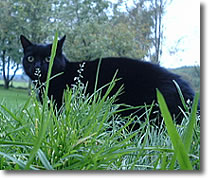Animal care and behaviour
Choosing a cat


Poesje Mauw who lives in Amsterdam, Holland.
See Also:
People have had cats as pets for thousands of years, and no-one knows for sure how cats were first chosen to be pets. Perhaps kittens from wild cats were raised by early humans, and the amused their carers by their antics.
It is likely that cats had become tamed and domesticated by as early as 6000 BC. A feline jawbone was found in the excavations of a Neolithic settlement in southern Cyprus in 1983. The location is significant as Cyprus has no fossil evidence of wild cats, so the cat must have been brought to the island by early human settlers. Certainly cats were fully domesticated 3,500 years ago, and records from ancient Egypt prove this. Cats were much revered there, and the punishment for killing one was death. When a cat died of natural causes all members of the household went into full mourning.
The Romans were responsible for bringing the cat to Britain and it is recorded that cats were well treated for centuries. They performed a useful service in ridding homes and grain stores of rats and mice. However in the Middle Ages the Christian Church proclaimed cats as evil, and saw them as linked to pagan rituals. The Church urged Christians to inflict pain and suffering on them. Cats were also accused of being the familiars of witches, and persecution of cats went hand in hand with persecution of women during the witch hunts of the seventeenth century. Yet cats survived, perhaps because ordinary people were too fond of their cats, or found them too useful to want to obey directives from the religious authorities. The persecutions eventually ceased, and the cat is now again a much loved pet, though we still have legends of cats on witches' broomsticks.

